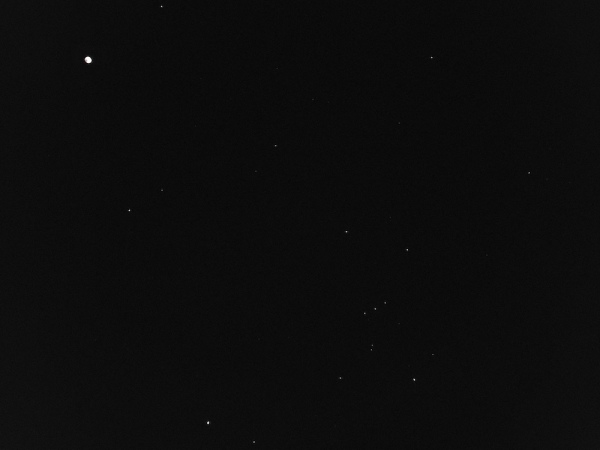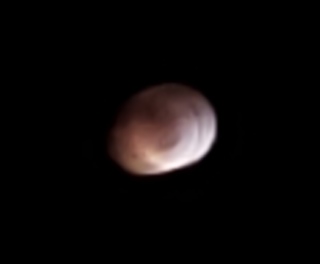The eclipse was not late, as eclipses go. Christine was able to get up a couple years ago to watch one in California. I'm not up for disturbing my sleep in the middle of the night, but this wasn't *that* late. Later than i normally stay up, but i'm sure i had six solid hours of sleep.

On a large enough screen you might be able to see Orion towards the right. The fully eclipsed moon left the sky dark and didn't blow out this image.
It was a cold night, but Christine struck on the idea of sitting in the car and getting the car toasty, so that worked admirably with the small exception that only one of us was able to sit in a relaxed position to watch. Oh, for a moon roof. Still, rather amazing to watch the night grow darker, the stars pop out of a moon blue sky, and eventually the moon turn red. (The shadow was in too much contrast to pick up color for quite a while.)

A hand held shot with lots of blur, but the red shows up.
The shots are nothing like the naked eye experience. We have a 200° x 150° visual field, per wikipedia, and the moon is just 1° wide. Yet we can focus on the detail within that 1° and (in my case) be aware there is more detail on the surface. (I can barely resolve stars in the seven sisters, so I know other people have sharper naked eye vision.) It takes the 10x magnification on the phone camera to begin to get the sense of visual size, yet that cuts off so much of the view. And when the phone widens out to the greatest field, the moon becomes a tiny dot.
In my memory, the last ten minutes before totality were striking as the bright penumbral light was still overwhelming the rest of the moon lost in the umbra. Then, at totality, the moon took on such a strange quality: how could something brighter than night black seem like a hole in the sky?
The most remarkable part of the experience for me was the change of light in the landscape. The full moon light, even in the penumbra, had been so bright i was able to get a sense of color in the yard. The sky was glowing and one could hardly see stars. As the umbra crossed the face of the moon the sense of an illuminated landscape faded, the stars became brighter, and neightbors' lights cast shadows through the trees.
This morning, Venus and Jupiter were bright, but i woke too late to see if they cast shadows. They are also low enough in the sky that they are lost in the trees. Tomorrow is their conjunction.

On a large enough screen you might be able to see Orion towards the right. The fully eclipsed moon left the sky dark and didn't blow out this image.
It was a cold night, but Christine struck on the idea of sitting in the car and getting the car toasty, so that worked admirably with the small exception that only one of us was able to sit in a relaxed position to watch. Oh, for a moon roof. Still, rather amazing to watch the night grow darker, the stars pop out of a moon blue sky, and eventually the moon turn red. (The shadow was in too much contrast to pick up color for quite a while.)

A hand held shot with lots of blur, but the red shows up.
The shots are nothing like the naked eye experience. We have a 200° x 150° visual field, per wikipedia, and the moon is just 1° wide. Yet we can focus on the detail within that 1° and (in my case) be aware there is more detail on the surface. (I can barely resolve stars in the seven sisters, so I know other people have sharper naked eye vision.) It takes the 10x magnification on the phone camera to begin to get the sense of visual size, yet that cuts off so much of the view. And when the phone widens out to the greatest field, the moon becomes a tiny dot.
In my memory, the last ten minutes before totality were striking as the bright penumbral light was still overwhelming the rest of the moon lost in the umbra. Then, at totality, the moon took on such a strange quality: how could something brighter than night black seem like a hole in the sky?
The most remarkable part of the experience for me was the change of light in the landscape. The full moon light, even in the penumbra, had been so bright i was able to get a sense of color in the yard. The sky was glowing and one could hardly see stars. As the umbra crossed the face of the moon the sense of an illuminated landscape faded, the stars became brighter, and neightbors' lights cast shadows through the trees.
This morning, Venus and Jupiter were bright, but i woke too late to see if they cast shadows. They are also low enough in the sky that they are lost in the trees. Tomorrow is their conjunction.
Tags: